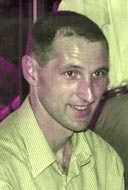|
Leonid MAC |
| home |
| View the shower |
| Mission Brief |
| Science Update |
| Media Brief |
| links |
 Dr.
Rüdiger Jehn, Dr.
Rüdiger Jehn,
ESA/ESOC, Europe 
Last updated: October 2002
Brief Biographical Information: Rüdiger Jehn, of German nationality, has a degree in mathematics. He joined the European Space Agency in 1989 and since 1991 he works for the European Space Operations Centre in Darmstadt as Space Debris and Mission Analyst. He received his PhD in 1996 for his thesis "Modelling Debris Clouds". He participates in the Inter-Agency Space Debris Coordination Committee (IADC), where the major space-faring nations discuss how to mitigate the problem of space debris. Other work areas include mission analysis for the International gamma ray laboratory INTEGRAL and interplanetary dust models for a planned Infrared Space Interferometry mission called DARWIN, whose objective is to look for live on other planets. Lately he is responsible for mission analysis for "BepiColombo", ESA's ambitious Mercury programme with a planned landing on the innermost planet of our solar system in the year 2012. With respect to the Leonids, he studied cometary ejection models to predict the Leonids activities in 2000 and 2001 (see paper in MNRAS). Research on Leonid MAC: near-real time flux measurements We will be part of the near-real time flux measurement team onboard NASA's DC-8, operating an intensified CCD camera that is identical to a camera operated from a ground location in Australia by an ESA team lead by Detlef Koschny. This camera plays the important role of helping to derive non-saturated fluxes in case the meteor shower activity rises much more than expected. Our goal is to provide near-real time flux measurements over a wide range of shower activity and to calibrate the flux measurements for observing conditions by comparing observations of the shower from different locations and under different observing conditions. We are especially interested to have a reliable rate count in case of an extreme storm as predicted by P. Jenniskens. Back home in Darmstadt at the European Space Operations Centre, the flux data will be used to monitor the risk for our operational satellites ERS-2, MARECS B2, ECS-4, XMM and Cluster.
|


